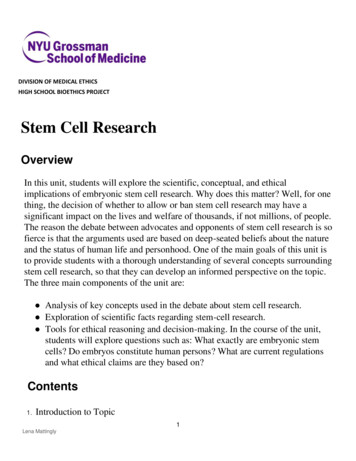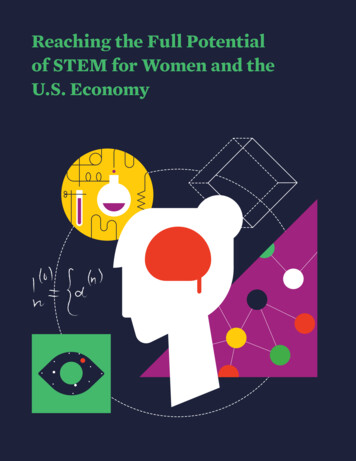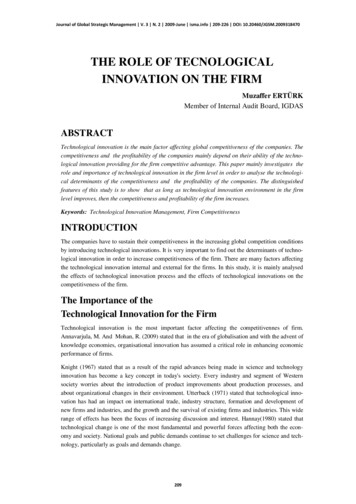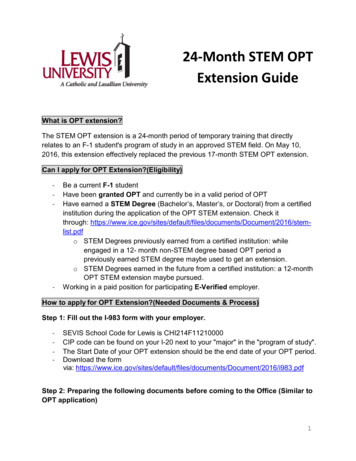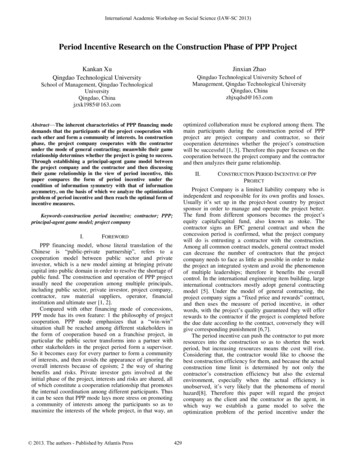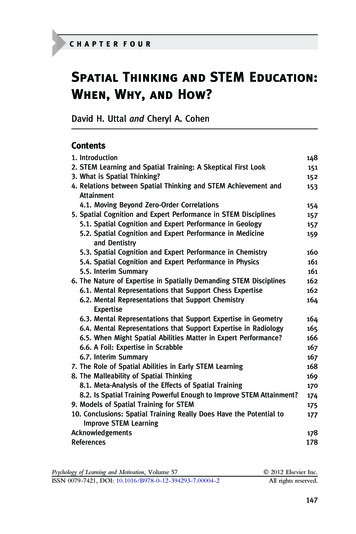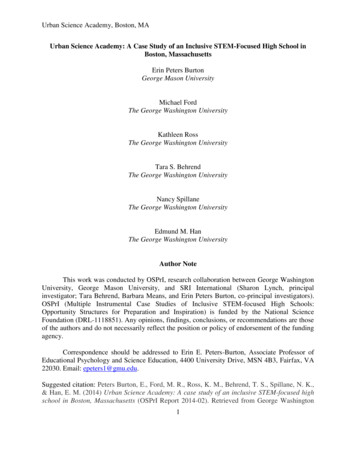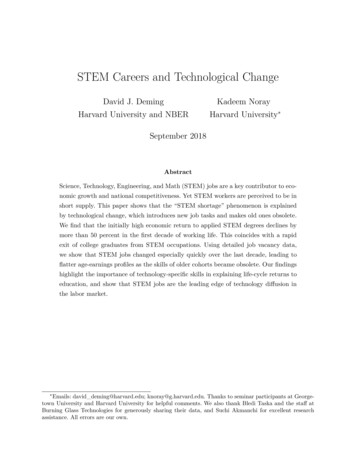
Transcription
STEM Careers and Technological ChangeDavid J. DemingKadeem NorayHarvard University and NBERHarvard University September 2018AbstractScience, Technology, Engineering, and Math (STEM) jobs are a key contributor to economic growth and national competitiveness. Yet STEM workers are perceived to be inshort supply. This paper shows that the “STEM shortage” phenomenon is explainedby technological change, which introduces new job tasks and makes old ones obsolete.We find that the initially high economic return to applied STEM degrees declines bymore than 50 percent in the first decade of working life. This coincides with a rapidexit of college graduates from STEM occupations. Using detailed job vacancy data,we show that STEM jobs changed especially quickly over the last decade, leading toflatter age-earnings profiles as the skills of older cohorts became obsolete. Our findingshighlight the importance of technology-specific skills in explaining life-cycle returns toeducation, and show that STEM jobs are the leading edge of technology diffusion inthe labor market. Emails: david deming@harvard.edu; knoray@g.harvard.edu. Thanks to seminar participants at Georgetown University and Harvard University for helpful comments. We also thank Bledi Taska and the staff atBurning Glass Technologies for generously sharing their data, and Suchi Akmanchi for excellent researchassistance. All errors are our own.
1IntroductionScience, Technology, Engineering, and Math (STEM) jobs are a key contributor to innovation and productivity growth in most advanced economies (e.g. Griliches 1992, Jones 1995,Carnevale et al. 2011, Peri et al. 2015). Despite the high labor market payoff for collegestudents majoring in STEM fields, there is a widespread perception that STEM workers arein short supply (Arcidiacono 2004, Carnevale et al. 2012, Kinsler and Pavan 2015, Cappelli2015, Arcidiacono et al. 2016). Yet STEM employment in the U.S. has grown slowly in thepast two decades, and 58 percent of STEM graduates leave the field within 10 years afterreceiving their degree (Carnevale et al. 2011, Charette 2013, Deming 2017).In this paper we argue that perceived skill shortages, high initial returns for STEM majorsand exit from STEM careers over time have a common cause - technological change, whichintroduces new job tasks and makes old tasks obsolete (e.g. Rosen 1975). STEM graduatesin applied subjects such as engineering and computer science earn higher wages initially,because they learn job-relevant skills in school. Yet over time, new technologies replace theskills and tasks originally learned by older graduates, causing them to experience flatterwage growth and eventually exit the STEM workforce. Faster technological progress createsa greater sense of shortage, but it is the new STEM skills that are scarce, not the workersthemselves.We document several new facts about labor market returns for STEM majors, whichcorroborate the argument above. The earnings premium for STEM majors is highest atlabor market entry, and declines by more than 50 percent in the first decade of working life.This pattern holds for “applied” STEM majors such as engineering and computer science, butnot for “pure” STEM majors such as biology, chemistry, physics and mathematics. Flatterwage growth coincides with a relatively rapid exit of STEM majors from STEM occupations.While some STEM majors move on to higher-paying occupations such as management, mostdo not. We show that the STEM premium holds primarily for STEM jobs – as opposed toSTEM majors – and that STEM jobs are disproportionately held by younger workers. These1
patterns are present in multiple data sources - both cross-sectional and longitudinal - and arerobust to controls for important determinants of earnings such as ability and family income,selection into graduate school, and other factors.We provide direct evidence on the changing technological requirements of jobs using anear-universe of online job vacancy data collected by the employment analytics firm BurningGlass Technologies (BGT). We use the BGT data to calculate a detailed measure of job taskchange over the 2007-2017 period. This measure captures how much the skill and task mixof an occupation has changed over a decade, and in what ways. We show that STEM jobsindeed have the highest rates of task change, and that this change is driven by the rise anddecline of specific software and business processes requested by employers.We interpret these patterns with a simple, stylized model of education and career choice.In our model, workers learn career-specific skills in school and are paid a competitive wage inthe labor market according to the skills they have acquired. Workers also learn on-the-job atdifferent rates according to their ability. Over time, the productivity gains from on-the-joblearning are lower in careers with higher rates of task change, because more of the taskslearned in past years become obsolete. The model predicts that jobs with high rates of taskchange will have flatter age-earnings profiles, and that they will disproportionately employyoung workers. We find strong support for these predictions in the data, for both STEM andnon-STEM occupations.Our model also predicts that the highest ability workers will choose STEM careers initially, but exit them over time. This is because the return to ability is higher in careers withlow rates of change, where knowledge can accumulate. Consistent with this prediction, wefind that worker with one standard deviation higher ability are 8 percentage points morelikely to work in STEM at age 24, but no more likely to work in STEM at age 40. We alsofind that the wage return to ability decreases strongly with age for STEM majors.While the BGT data only go back to 2007, we calculate a similar measure of job taskchange using a historical dataset of classified job ads assembled by Atalay et al. (2018).2
We show that the computer and IT revolution of the 1980s coincided with higher rates oftechnological change in STEM jobs, and that young STEM workers were also paid relativelyhigh wages during this same period. This matches the pattern of evidence for the 20072017 period and confirms that the relationship between STEM careers, job change andage-earnings profiles is not specific to the most recent decade.This paper makes three main contributions. First, we introduce new evidence on theeconomic payoff to STEM majors and STEM careers, and we argue that it is consistent withthe returns to technology-specific human capital becoming less valuable as new tasks areintroduced to the workplace.1Second, our results provide an empirical foundation for a large body of work in economicson vintage capital and technology diffusion (e.g. Griliches 1957, Chari and Hopenhayn 1991,Parente 1994, Jovanovic and Nyarko 1996, Violante 2002, Kredler 2014. In vintage capitalmodels, the rate of technological change governs the diffusion rate and the extent of economicgrowth (Chari and Hopenhayn 1991, Kredler 2014). We provide direct empirical evidence onthis important parameter, and our results match some of the key predictions of these classicmodels.2 Consistent with our findings, Krueger and Kumar (2004)show that an increase inthe rate of technological change increases the optimal subsidy for general vs. vocationaleducation, because general education facilitates the learning of new technologies.Third, the results enrich our understanding of the impact of technology on labor markets.Past work either assumes that technological change benefits skilled workers because they1Most existing work focuses on the determinants of college major choice when students have heterogeneous preferences and/or learn over time about their ability (e.g. Altonji, Blom and Meghir 2012, Webber2014, Silos and Smith 2015, Altonji, Arcidiacono and Maurel 2016, Arcidiacono et al. 2016, Ransom 2016,Leighton and Speer 2017). An important exception is Kinsler and Pavan (2015), who develop a structuralmodel with major-specific human capital and show that science majors earn much higher wages in sciencejobs even after controlling for SAT scores, high school GPA and worker fixed effects. Hastings et al. (2013)and Kirkeboen et al. (2016) find large impacts of major choice on earnings after accounting for self-selection,although neither study explores the career dynamics of earnings gains from majoring in STEM fields.2In Chari and Hopenhayn (1991) and Kredler (2014), new technologies require vintage-specific skills,and an increase in the rate of technological change raises the returns for newer vintages and flattens theage-earnings profile. However, the equilibria in these models requires newer vintages to have lower startingwages but faster wage growth. A key difference in our model is that we allow for learning in school, whichhelps explain the initially high wage premium for STEM majors. In Gould et al. (2001), workers makeprecautionary investments in general education to insure against obsolescence of technology-specific skills.3
adapt more quickly, or links a priori theories about the impact of computerization to shiftsin relative employment and wages across occupations with different task requirements (e.g.Galor and Tsiddon 1997, Caselli 1999, Autor et al. 2003, Firpo et al. 2011, Deming 2017).We measure changing job task requirements directly and within narrowly defined occupationcategories, rather than inferring it indirectly from changes in relative wages and skill supplies(Card and DiNardo 2002). A large body of work in economics has shown how technologicalchange at the macro level leads to fundamental changes in job tasks such as greater useof computers, more emphasis on lateral communication and decentralized decision-makingwith the firm (e.g. Autor et al. 2002, Bresnahan et al. 2002, Bartel et al. 2007). Our resultsbroadly corroborate the findings of this literature, while also highlighting how STEM jobsare the leading edge of technology diffusion in the labor market.This paper builds on a line of work studying skill obsolescence, beginning with Rosen(1975). McDowell (1982) studies the decay rate of citations to academic work in differentfields, finding higher decay rates for physics and chemistry compared to history and English. Neuman and Weiss (1995) infer skill obsolescence from the shape of wage profiles in“high-tech” fields, and Thompson (2003) studies changes in the age-earnings profile after theintroduction of new technologies in the Canadian Merchant Marine in the late 19th century.Our results are also related to a small number of studies of the relationship between age andtechnology adoption. MacDonald and Weisbach (2004) develop a “has-been” model whereskill obsolescence among older workers is increasing in the pace of technological change, andthey use the inverted age-earnings profile of architects as a motivating example.3 Friedberg(2003) and Weinberg (2004) study age patterns of computer adoption in the workplace, whileAubert et al. (2006) find that innovative firms are more likely to hire younger workers.Advanced economies differ widely in the policies and institutions that support school-to3MacDonald and Weisbach (2004) argue that “Advances in computing have revolutionized thefield.Older architects have found it uneconomic to master the complex computer skills that enable theyoung to produce architectural services so easily and flexibly.Thus these advances have allowed youngerarchitects to serve much of the market for architectural services, causing the older generation to lose much ofits business.” Similarly, Galenson and Weinberg (2000) show that changing demand for fine art in the 1950scaused a decline in the age at which successful artists typically produced their best work.4
work transitions for young people (Ryan 2001). Hanushek et al. (2017) find that countriesemphasizing apprenticeships and vocational training have lower youth unemployment ratesat labor market entry but higher rates later in life, suggesting a tradeoff between general andspecific skills. Our results show that this tradeoff also holds for field of study in U.S. fouryear colleges. Applied STEM degrees provide high-skilled vocational education, which paysoff in the short-run because it is at the technological frontier. However, since technologicalprogress erodes the value of these skills over time, the long-run payoff to STEM majors islikely much smaller than short-run comparisons suggest. More generally, the labor marketimpact of rapid technological change depends critically on the extent to which schooling and“lifelong learning” can help build the skills of the next generation (Selingo 2018).The remainder of the paper proceeds as follows. Section 2 describes the data and documents the main empirical patterns described above. Section 3 presents the model anddevelops a set of empirical predictions. Section 4 presents the main results and connectsthem to the predictions of the model. Section 5 studies job task change in earlier periods.Section 6 concludes.2Data2.1Labor Market Data and Descriptive StatisticsOur main data source is the 2009-2016 American Community Surveys (ACS), extracted fromthe Integrated Public Use Microdata Series (IPUMS) 1 percent samples (Ruggles et al. 2017).The ACS has collected data on college major since 2009. Following Peri et al. (2015), weadopt the definition of STEM major used by the U.S. Department of Homeland Security indetermining visitor eligibility for an F-1 Optional Practical Training (OPT) extension.4 Thisdefinition is relatively restrictive and excludes majors such as psychology, economics nts/Document/2016/stem-list.pdf. Peri et al. (2015)create a crosswalk between these codes and those collected by the ACS. We use their crosswalk, exceptwe further exclude Psychology and some Health Science and Agriculture-related majors.5
nursing used in past work (e.g. Carnevale et al. 2011). We further classify STEM majors intotwo groups - “applied” science, which includes computer science, engineering and engineeringtechnologies, and “pure” science, which includes biology, chemistry, physics, environmentalscience, mathematics and statistics. We use the 2010 Census Bureau definition of STEMoccupations in all of our analyses.5We also use data from the 1993-2013 waves of the National Survey of College Graduates(NSCG), a survey administered by the National Science Foundation (NSF). The NSCG isa stratified random sample of college graduates which employs the decennial Census as aninitial frame, while oversampling individuals in STEM majors and occupations. The majorclassifications in the NSCG are very similar to the ACS, and we use a consistent definitionof STEM major across the two data sources. However, the NSCG occupation definitions arecoarse and do not map cleanly to the ACS. Finally, for some analyses we use data from theAnnual Social and Economic Supplement (ASEC) of the Current Population Survey (CPS).The CPS covers a longer time period than the ACS, but does not collect data on collegemajor.Our main outcome of interest in the ACS is the natural log of wage and salary incomefor workers who are employed at the time of the survey and report working at least 40 weeksin the previous year. The NSCG only asks about annual salary in the current job, and asksworkers who are not paid a salary to estimate their annual earnings. However, the NSCG doesask about (current) full-time employment, and we restrict the sample to full-time employedworkers in our main results. In both samples we adjust earnings to constant 2016 dollarsusing the Consumer Price Index (CPI).We restrict our main analysis sample to men with at least a bachelor’s degree betweenthe ages 23 to 50 in the ACS and CPS, and ages 25-50 in the NSCG.6 We are interestedin studying the life-cycle profile of returns to STEM degrees, and large changes across e-lists.html.6The sample design of the NSCG resulted in very few college graduates age 23-24, so we exclude thissmall group from our analysis.6
cohorts in educational attainment for women, as well as cohort differences in the age profileof female labor force participation make comparisons over time difficult (e.g. Goldin et al.2006, Black et al. 2017).7 Finally, to maximize consistency across data sources, we restrictthe sample to non-veteran US-born citizens who are not living in group quarters and notcurrently enrolled in school. Our ACS results are not sensitive to these sample restrictions.We supplement these two large, cross-sectional data sources with the 1979 and 1997waves of the National Longitudinal Survey of Youth (NLSY), two nationally representativelongitudinal surveys which include detailed measures of pre-market skills, schooling experiences and wages. The NLSY-79 starts with a sample of youth ages 14 to 22 in 1979, whilethe NLSY-97 starts with youth age 12-16 in 1997. The NLSY-79 was collected annually from1979 to 1993 and biannually thereafter, whereas the NLSY-97 was always biannual. We restrict our NLSY analysis sample to ages 23-34 to exploit the age overlap across waves. Weuse respondents’ standardized scores on the Armed Forces Qualifying Test (AFQT) to proxyfor ability, following many other studies (e.g. Neal and Johnson 1996, Altonji, Bharadwajand Lange 2012).8 Our main outcome is the real log hourly wage (in constant 2016 dollars),and we trim values of the real hourly wage that are below 3 and above 200, following Altonji,Bharadwaj and Lange (2012). We follow the major classification scheme for the NLSY usedby Altonji, Kahn and Speer (2016). Finally, we generate consistent occupation codes (andSTEM classifications) across NLSY waves using the Census occupation crosswalks developedby Autor and Dorn (2013).7From 1995 to 2015, the share of women age 25 with a BA or higher grew from 20.2 percent to 32.7percent, more than double the rate of growth for men (Digest of Education Statistics, 2017). AppendixFigures A1 and A2 present results for women, which are broadly similar to results for men over the 23-35age period.8Altonji, Bharadwaj and Lange (2012)construct a mapping of the AFQT score across NLSY waves thatis designed to account for differences in age-at-test, test format and other idiosyncracies. We take the rawscores from Altonji, Bharadwaj and Lange (2012) and normalize them to have mean zero and standarddeviation one.7
2.2Declining Life-Cycle Returns to STEMTable 1 presents population-weighted descriptive statistics by college major and age, using the ACS. The odd-numbered columns show average earnings, while the even-numberedcolumns show share working in a STEM occupation. Columns 1-4 present results that compare STEM majors to all other non-STEM majors, while Columns 5-6 and 7-8 show “Pure”and “Applied” Science majors respectively. While earnings increase substantially over thelife-cycle for all college graduates regardless of major, STEM majors earn substantially moreat labor market entry and experience relatively slower wage growth over the first decade ofworking life. Dividing Column 3 by Column 1 yields a STEM wage premium of 30 percentat age 24 but only 18 percent at age 35.The age pattern of earnings is starkly different by STEM major type. Applied Sciencemajors such as computer science and engineering earn the highest starting salaries, yet theyalso experience the flattest wage growth. The earnings premium for an Applied Science majorrelative to a non-STEM major is 44 percent at age 24, but drops to 14 percent by age 35.9In contrast, Pure Science majors such as biology, chemistry, physics and mathematics earna relatively small initial wage premium that grows with time.This pattern of flatter wage growth for Applied Science majors closely matches theirexit from STEM occupations over time. The share of Applied Science majors holding STEMjobs declines from 89 percent at age 24 to 71 percent at age 35, and continues to declinethereafter. The share of Pure Science majors in STEM jobs also declines, from 35 percent atage 24 to 27 percent at age 35. The share of non-STEM majors in STEM jobs stays constantat around 12 percent.To examine these patterns more systematically, we estimate regressions of the followinggeneral form:9The ACS does not collect information about the type of college attended. Thus one explanation for partof the high initial earnings premium for STEM majors is that they are drawn heavily from more selectivecolleges, which also have higher on-time graduation rates and (by implication) full-time workers by age 23(e.g. Hoxby 2017).8
ln yit αit A aβa Ait A γa (Ait ASit ) aA δa (Ait P Sit ) ζXit θt ϵit(1)awhere ait is an indicator function I (Age a)it that is equal to one if respondent i inyear t is either age in two year bins a, going from ages 23-24 to ages 49-50. ait ASit andait P Sit are interactions between age bins and indicator functions that are equal to oneif a respondent has an Applied Science or Pure Science major respectively. The γ and δcoefficients can be interpreted as the wage premium for Applied Science and Pure Sciencemajors relative to all other college majors, for each age group. The X vector includes controlsfor race and ethnicity and years of completed education, θt represents year fixed effects, andϵit is an error term.Figure 1 presents population-weighted estimates of equation (1) for full-time workingmen ages 23-50 with at least a bachelor’s degree. Panel A presents results using the ACS,and Panel B presents results using the NSCG. Each point in Figure 1 is a γ or δ coefficientand associated 95 percent confidence interval. The ACS and NSCG are both nationallyrepresentative, but for different years, with the ACS covering 2009-2016 and the NSCGcovering 1993-2013.10We find a strong life-cycle pattern in the labor market payoff to Applied Science degrees.In the ACS, college graduates with degrees in engineering and computer science earn about 39percent more than non-STEM degree holders at ages 23-24. This earnings premium declinesto about 26 percent by age 30 and 17.5 percent by age 40, leveling off thereafter. In contrast,the return to a Pure Science degree is near zero initially but start to grow beginning in themid 30s, reaching 12 percent at 40 and 16 percent at age 50. This is largely explained bythe high rate of graduate degree attainment - 52 percent by age 35, compared to 28 percentand 32 percent for Applied Science and non-STEM degrees respectively.1110The results are very similar when we restrict the NSCG sample to years after or before 2008, coveringthe cases that do and do not overlap with the ACS respectively.11Appendix Figure A5 shows that excluding workers with graduate degrees flattens the return to pure9
Panel B shows very similar patterns in the NSCG sample. Applied Science majors earna premium of about 46 percent at ages 25-26. This declines to 27 percent by age 30 and 21percent by age 40, and again levels off over the next decade. The returns to a Pure Sciencedegree in the NSCG are initially near zero but grow modestly over time.Overall, the payoff to Engineering and Computer Science degrees is initially very high,but declines by more than 50 percent in the first decade of working life. Appendix Figure A3shows estimates of equation (1), but with an indicator for working in a STEM occupation asthe outcome variable. Applied Science degree holders exit from STEM occupations rapidlyin the first 10-15 years after college, and timing coincides closely with the earnings resultsin Figure 1. Appendix Figure A4 shows that the probability of full-time employment alsodeclines over the life-cycle for Applied Science majors, while the opposite holds for PureScience.The results in Figure 1 are robust to a variety of alternative specifications and sample definitions.12 Appendix Figures A5, A6 and A7 presents results that include part-timeworkers, that exclude workers with graduate degrees, and that add industry fixed effectsrespectively. These yield very similar results. Appendix Figures A8 and A9 show results thatgroup all STEM degrees together and that separate out engineering and computer sciencerespectively.Figure 2 presents estimates of equation (1) where age is interacted with indicators forworking in a STEM occupation, using the ACS, the NSCG and the CPS (which does notinclude information on college major). Despite the fact that each data source spans differentyears and has a different sampling frame, each shows the same pattern of declining life-cyclescience degrees, suggesting that part of the growth in Figure 1 reflects selection into graduate school overtime. Appendix Table A1 studies selection into graduate school using the NLSY. We find that while graduateschool attendance is overall more common in later years (e.g. the NLSY97 vs. the NLSY79), selection intograduate school by ability has not changed over time. While high-ability college graduates are more likelyto attend graduate school, this is modestly less true for STEM majors.12Hanson and Slaughter (2016) document the rising share of high-skilled immigrants in U.S. STEM fields.To the extent that immigrants are a better substitute for younger workers, rising immigration over time willtend to depress relative wages for younger workers, which works against our findings. Additionally, we findthat the share of college graduates in STEM fields has not changed very much over the cohorts we study inthe ACS.10
returns to working in a STEM occupation.Is declining returns an inherent feature of STEM jobs, or is it something about thecharacteristics of students who choose to major in STEM? To disentangle majors from occupations, we estimate a version of equation (1) that adds interactions between age categoriesand indicators for being employed in a STEM occupation, as well as three-way interactionsbetween age, an Applied Science major and STEM employment.13 This allows us to separately estimate the relative earnings premia for Applied Science degree-holders working innon-STEM jobs, for other majors working in STEM jobs, and for Applied Science majors inSTEM jobs.The results are in Figure 3. Declining relative returns to STEM is a feature of the job, notthe major. Applied Science degree holders working in non-STEM occupations earn around15 percent more than those with other majors, and this premium is relatively constantthroughout their working life. The STEM major premium could reflect differences in unobserved ability across majors, or differences in other job characteristics (e.g. Kinsler andPavan 2015).14In contrast, we find a strong life-cycle earnings pattern for STEM workers with othermajors. The earnings premium for non-STEM majors in STEM occupations is about 32percent at ages 23-24 but declines rapidly to 7.5 percent within a decade. The pattern issimilar for Applied Science majors in STEM jobs, with earnings premia declining from 59percent to around 17 percent by age 40. Within a decade of college graduation, AppliedScience majors earn the same amount in STEM and non-STEM occupations.The patterns in Figure 3 yield three key insights. First, STEM jobs pay relatively higherwages to younger workers, and this is true for Applied Science degree holders but also for13The results for Applied Science are very similar when we also include similar interactions for PureScience majors and STEM occupations, although we exclude these interactions for simplicity. Unfortunately,the measures of occupation are too coarse and non-standard in the NSCG to estimate equation (2) in a waythat is comparable to the ACS.14Appendix Figure A10 adds industry fixed effects to the results in Figure 3, which produces generallysimilar results except that the return to Applied Science majors in non-STEM occupations drops by about50 percent.11
other majors as well. Second, this benefit dissipates within 10-15 years after labor marketentry, after which time there is little or no payoff to working in a STEM job regardless ofone’s college major. Third, the flatter age-earnings profile holds for STEM occupations, notSTEM majors.2.3Measuring Technological Change at the Job Task LevelWhy do STEM careers have flatter age-earnings profiles? One possible reason is that therequirements of STEM jobs change over time, rendering previously learned job tasks obsolete.In order to study obsolescence directly, it is necessary to measure changing job task demandswithin narrowly defined job categories (e.g. Autor and Handel 2013).We study changing job requirements using data from Burning Glass Technologies (BG),an employment analytics and labor market information firm that scrapes job vacancy datafrom more than 40,000 online job boards and company websites. BG applies an algorithmto the raw scraped data that removes duplicate postings and parses the data into a numberof fields, including job title and six digit Standard Occupational Classification (SOC) code,industry, firm, location, and education and work experience. BG also codes key words andphrases into a very large number of unique skill requirements. More than 93 percent of alljob ads have at least one skill requirement, and the average number is 9. These range fromvague and general (e.g Detail-Oriented, Problem-Solving, Communication Skills) to detailedand job-specific (e.g. Phlebotomy, Javascript, Truck Driving). BG began collecting data in2007, and our data span the 2007-2017 period.15Vacancy data are ideal for measuring the changing task requirements of jobs, for tworeasons. First, vacancies directly measure employer demand. Second, vacancy data allowfor a detailed study of changing task demands within occupations over time. Due to data15See Hershbein and Kahn (2018) and Deming and Kahn (2018) for more detail on the coverage of BGdata and comparisons to other sources such as the Job Openings
Section 2 describes the data and doc-uments the main empirical patterns described above. Section 3 presents the model and develops a set of empirical predictions. Section 4 presents the main results and connects them to the predictions of the model. Section 5 studies job task change in earlier periods. Section6concludes. 2 Data
